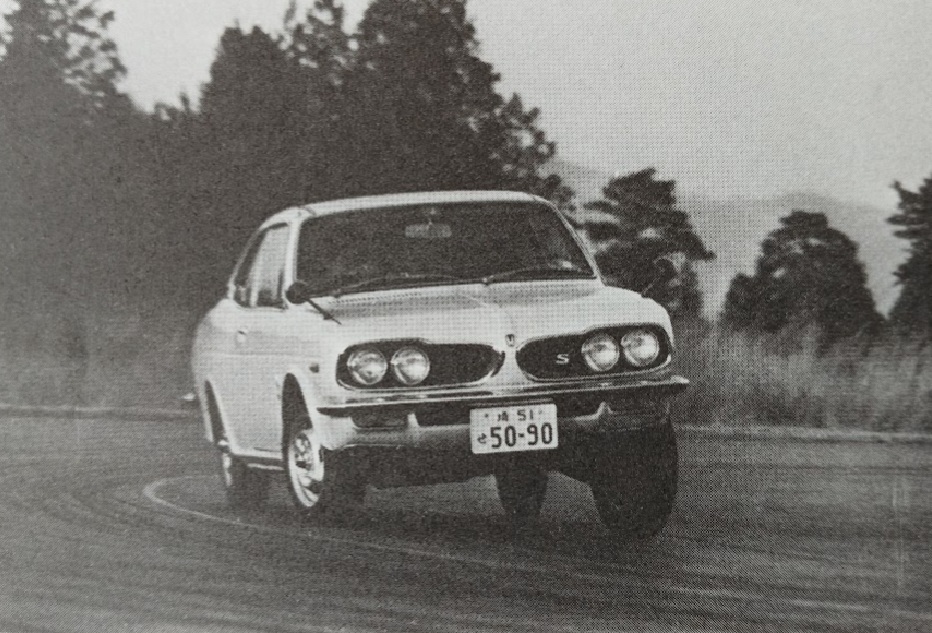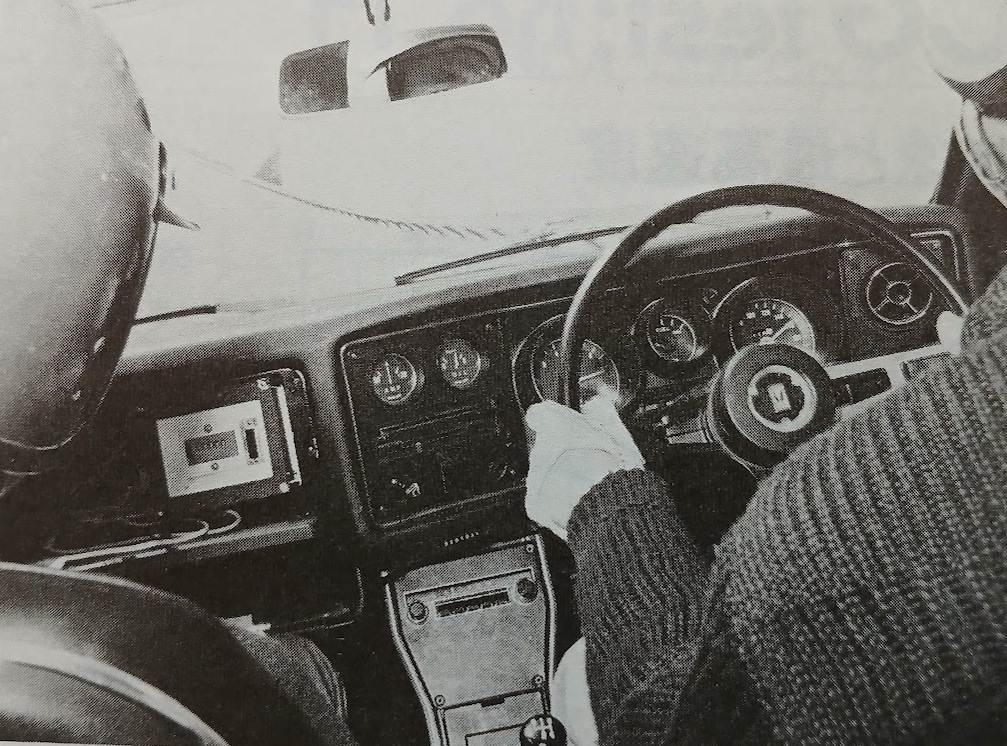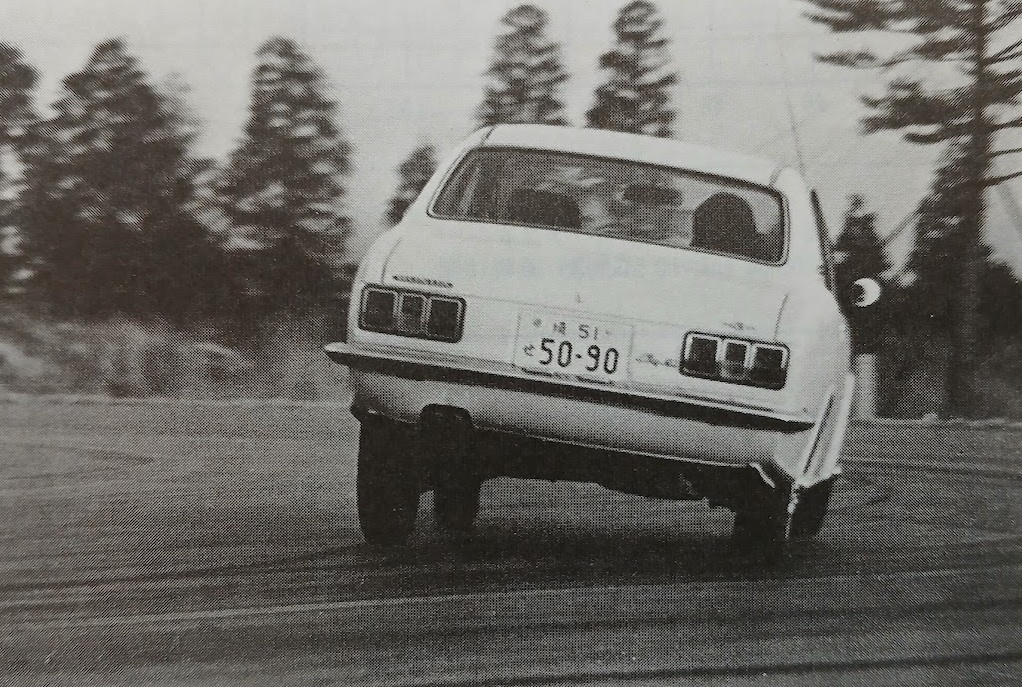Honda 1300 Coupe 9S (1970)

Publication: Car Graphic
Format: Road Test
Date: April 1970
Author: “C/G Test Group” (uncredited)
Summary: A highly practical five-seater coupe based on the 1300 sedan. Roominess not inferior to the sedan. Air-cooled engine with four carburetors. Exceptional power. Stiffer unibody construction and suspension than the sedan, chassis finally catching up with the engine. Maneuverability significantly improved over the sedan.
Road testing the Honda 1300 Coupe 9S
When we tested the Honda 1300 77 in the February issue, we were very impressed by its excellent engine, but criticized its chassis for being too weak to handle it, and for being unable to safely utilize its great power performance. The 77 Deluxe we tested for that report was a very early production model (chassis number H1300-1000611) that was purchased by C/G for long-term testing, and during the approximately 20,000km that we had it, it had frequent problems, so the passion we had initially felt for the Honda 1300 gradually faded.
Later, as mass production progressed, we began to hear people say that the Honda 1300 had improved a lot, but when we occasionally borrowed one to drive, we couldn’t find any improvements significant enough to convince us.
However, after testing the recently released Coupe 9, our opinion of the Honda 1300 has been significantly revised. In short, the handling of the Coupe 9 has improved beyond imagination from the C/G 1300 77 sedan, and it feels like a completely different car.
According to reports, the Honda 1300 seems to vary greatly from one example to the next, so it is dangerous to judge the whole series based on the experience of driving just one car. So, in the case of the Coupe 9, we drove both the Deluxe and S models (which are identical mechanically, differing only in interior equipment), and both showed similar behavior, so the skeptical C/G test group was finally convinced.
There are two 1300 Coupe models: the Coupe 7, which is equivalent to the 77 sedan, with a single carburetor, and the high-performance four-carburetor Coupe 9, each of which offers variations in the interior and trim. We drove the Coupe 9 Deluxe and S models, but since it was the S that was tested at Yatabe, we will mainly talk about that model (as mentioned above, all Coupe 9 models are mechanically the same).
In the February test of the 77 sedan, our main criticism was around handling and stability: simply put, the suspension was too soft for the car’s speed potential, and the standard tires (6.2S-13) were too feeble, which combined to cause excessive understeer in corners, which could be dangerous.
As soon as we got into the Coupe 9S and rounded the first corner, we noticed that the steering response was much better and the degree of understeer was greatly reduced. We tried slalom-style maneuvers at 130-140km/h, and found that the car rolled much less than the sedan and followed the steering faithfully. The steering is still far from the precision expected from a rack-and-pinion mechanism, but it is now at least accurate enough that an average driver can guide it at high speed without any problems (in the case of the sedan with its standard tires, there is a large time lag between the driver’s steering inputs and the actual steering effect). Also, in the cornering test on the skid pad, the Coupe is much less likely to become a “three-wheeler” than the C/G 77 sedan. Even cornering at the limit where the inside rear wheel lifts off the ground, the front wheels still have enough cornering power to control the car. The tendency to roll inward when the throttle is released during cornering is also less severe than in any other Honda 1300 sedan we have driven. In short, the handling characteristics that are considered to be the “negatives” of front-wheel-drive are almost completely eliminated in this Coupe 9S, and instead the advantages of front-wheel-drive are brought to the forefront.
What is the key to this remarkable transformation of the Honda 1300? First of all, it is the tires. The test car was fitted with Dunlop GS1 6.2H-13 tires, which, as we noted in the February issue’s road test, have also completely transformed the handling of the C/G 77 sedan. Although the tire is of four-ply construction, its stiffness is essentially equivalent to that of six-ply tires, and its high sidewall rigidity is thought to be particularly well-suited to the Honda 1300, which has a heavy front wheel load. Next is the design of the coupe’s suspension. The rear suspension of the coupe and sedan are slightly different. In the sedan, the “cross beam” axles and leaf springs are connected by two pins, one above and one below (called a floating joint), and a shackle, with the axle swinging around this pin as a fulcrum, so that the spring is only subjected to vertical loads. In the coupe, the lower pin of this floating joint has been eliminated, and the axle swings with only the upper pin. This means that the spring is subjected to some twisting, but the lateral rigidity of the rear suspension has increased slightly. The damper settings are different between the 7 and 9 (the sedans are also different between the 77 and 99), and the damping force of the 7 is 40kg on the extension side and 10kg on the compression side, while the 9 is 50kg and 20kg, respectively. Furthermore, the coupe has a lower center of gravity than the sedan. We think it is the combination of these factors that is responsible for the 9S Coupe’s very good handling and stability, especially compared to the 77 sedan.
The Coupe 9’s ride feels firm, but this is probably due in part to the psychological effect of the tire noise. It is certainly firmer than the 1300 77 sedan, and does not “float” even when going over undulating surfaces at high speeds (the C/G 77 is prone to porpoising in such situations), and the tires feel as if they are overinflated, clearly picking up joints in the pavement (although not as much as radials). However, the ride is still very comfortable on all surfaces. Small irregularities are absorbed well by the suspension, and are mostly heard as tire noise rather than felt. The ride is also excellent on rough roads, and directional stability is not easily affected by the road surface, so a high average speed can be maintained on unsealed surfaces. The power is sufficient, as well, and we discussed that if we just added a sump guard, it would make a great rally car even in stock condition.
The adhesion of the Dunlop GS1 6.2H-13 tires was found to be very high both in tests on the skid pad and during hill climbing. Even when powering around tight corners in second gear, there was very little wheelspin, and once the tires gripped the road, the engine’s plentiful low-speed torque immediately translated into powerful acceleration. The 1300 Coupe is an ideal hill climber.
However, you need to be careful when going downhill. The weight distribution of a nose-heavy front-wheel-drive car is already terrible when braking downhill. If you accidentally enter a corner at too high a speed and then brake (and usually with the steering wheel turned hard), the tires will lock and scrub straight ahead, and you will lose all control. With the Coupe 9’s better tires and firmer suspension, the danger is much less than in the 77 sedan, but caution is still required due to its high speed potential (this is not limited to the Honda, but is true for all powerful front-wheel-drive vehicles).
Last December, the Honda 1300’s engine was modified to increase low and mid-range torque and make it easier to handle. The cams were changed to have less overlap, and the ignition timing was also changed, resulting in a 5ps drop in outout in the 99 to 110ps/7300rpm. Maximum torque was also lowered slightly to 11.5kgm/5000rpm, but the torque curve became flatter. Of course, the Coupe 9 has the same 110ps engine.
People who buy this coupe because they are attracted to Honda’s reputation for speed will be fully satisfied. First, to give you some figures, it ran at an average top speed of 171.4km/h on the 1km straight at the Yatabe test course, and 169.1km/h on the 5.5km circuit course. The instantaneous top speed achieved with the fifth wheel attached reached about 173km/h. It also recorded a consistent 0-400m acceleration time of 17.5 seconds. All measurements were taken with two occupants on board, about 40kg of test equipment, and a full tank of fuel.
Recent Honda 1300 engines have a device built into the distributor that cuts off the ignition spark to prevent over-revving; it’s a very simple mechanism in which the rotor terminal is pulled back by centrifugal force, suppressing the spark, and in the case of the Coupe 9, it prevents the engine from going over 7500rpm (the start of the red zone on the rev counter). The C/G 77 sedan, which does not have this feature, can easily rev over 8000rpm, and the valve gear response is still perfect even at that speed, so this is probably out of consideration for durability.
There is no need to write again about the greatness of the Honda 1300 engine. Even though we are familiar with this engine from the 77 sedan, when we first drove the Coupe 9, we were still impressed by its power and how quickly it responded to the throttle. It was turbine-smooth over a wide range of revolutions, and it was hard to believe that it was a reciprocating four-cylinder engine. In fact, the Honda 1300 engine is said to be quieter than a water-cooled engine up to high speeds. This Coupe 9 also did not have the “dry” noise that is characteristic of air-cooled engines, but the noise level was a little higher than in other Honda 1300s we have driven. From around 4000rpm, a strong roar filled the cabin under full throttle.
The power is always more than sufficient throughout the rev range, so whenever you step on the throttle, the car responds instantly and accelerates responsively. When you find a small gap in traffic on a national highway and want to quickly overtake a line of cars, the extra power certainly contributes to what Honda calls “active safety.” Acceleration in third gear, in particular, can only be described as “indulgent.”
The difference in power between the single-carb and four-carb engines is especially evident in top gear above 100km/h. For example, the acceleration time from 60 to 100km/h is 10.2 seconds for the Coupe 9 (11.9 seconds for the 77 sedan), 10.3 seconds (12.2 seconds) from 80 to 120km/h, and 13.5 seconds (19.0 seconds) from 100 to 140km/h. The latter figure is a full 5.5 seconds faster than the 77 sedan. On the other hand, acceleration from a standing start is not as fast as the 77 sedan (for example, the 0-1000m time is 34.8 seconds for the Coupe and 32.6 seconds for the sedan). This is probably due to the ignition cut-off, which limits the maximum rpm to 7500rpm. The instantaneous top speed of 173km/h at Yatabe was also achieved at 7450rpm, practically the engine’s allowable rev limit, and once or twice it seemed to exceed 7500rpm on a slight downhill gradient (making good use of exiting the banking to create a slight coasting force), which nearly triggered the cut-off. At the very least, it seems impossible to achieve the manufacturer’s claimed top speed of 185km/h, even with a tailwind, unless the cut-off was removed.
On the other hand, one of the Honda’s favorable characteristics is that its power holds up well even at low speeds. Anyone familiar with Hondas knows their reputation for high engine revolutions, and is tempted to push them so hard that the rev counter is spinning in circles. However, the 1300’s engine is flexible enough that it can accelerate smoothly from under 40km/h (about 1700rpm) in top gear, and if you feel like it, you can learn to drive quickly and quietly using only low revs.
Surprisingly, this four-carburetor 110ps coupe returned better fuel economy overall than the C/G 77 sedan. This was true even at constant speeds, and especially clear when driving at a steady 100km/h on the highway. The C/G 77 sedan never reached 10km/l even when measured on the Tomei Expressway, but the Coupe 9 recorded 12.5km/l under the same conditions. Even in urban areas, it is slightly better than the C/G 77, and can reliably get 6.5 to 7.5km/l. On the other hand, while the 77 uses regular-grade gasoline, the Coupe 9 requires super.
In the test report for the 77 sedan, we pointed out its poor warm-up characteristics after a cold start, but starting with 1300s produced in December 1969, a device was installed that sucks in warm air heated by the exhaust pipe. The test Coupe 9 was also fitted with this device, and it idled smoothly immediately after a cold start, and pulled powerfully as soon as it moved away from rest, so it can be said to be extremely effective.
The front brakes are different from the sedan’s in that the calipers are a Sumitomo three-pot type. The servo is also stronger than in the 77, so just applying the weight of your shoes rather than consciously stepping on the pedal applies about 0.3g (the same as stopping in normal city driving). With the coupe’s stiffer suspension, there is relatively little nose dive when braking, which is an improvement. In the 0-100-0 test, the pedal force only increased from 15kg to 22kg on the tenth stop, so it can be considered safe for repeated use at high speeds.
The coupe’s seating is lower than in the sedan, the steering column is tilted slightly downward to meet the driver at less of an angle, and the slightly larger steering wheel is relatively low. As a result, the driving position feels much more natural than that of the sedan. The instrument panel, called the “flight cockpit,” is a little ostentatious, but all the gauges are large and easier to read than in the sedan, both day and night. The seat upholstery looks like leather at first glance, and is softer and more comfortable than in the sedan. The rear floor is flat, so three people can sit comfortably. The accommodations are more like that of a two-door sedan than a coupe, and the high window sills front and rear provide a moderate amount of privacy and a sense of protection. The rigidity of the body, especially in the rear, seems higher than that of the sedan, as we found when driving on rough roads. The interior finish is also generally acknowledged to have significantly improved compared to early production cars.
When it comes to styling, individual tastes vary, but in our experience, the Honda 1300 Coupe, which looks like a miniature Pontiac GTO, attracted attention wherever it went.
After testing the Coupe, we felt that Honda made two important mistakes with the 1300: first, the 1300 sedan was brought to market too early, and second, the coupe was brought to market too late.
Postscript: Story Photos

